Annelid Characteristics
- Well developed true coelom
- Segmented (reduced or lost in some)
- Complete digestive tract with regional specialization
- Closed circulatory system with respiratory pigments
- Well-developed nervous system
- Usually with lateral chaetae (spines) on each segment
- Marine, fresh water, and terrestrial environments
|
|
Class Polychaeta
Subclass Errantia — Free-swimming Worms
Characteristics
- Numerous chaetae (setae) on segments
- Most have well-developed parapodia
- Most have sensory tentacles and eyes on head
- Many have chitinous jaws
- Lack clitellum
- Marine or brackish waters
- Mobile (errant): crawl over substrates or swim
- The monophyly of this group is not certain
|
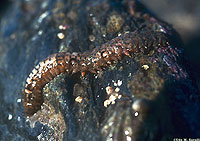
Scale Worm, Halosydna brevisetosa, CA
|
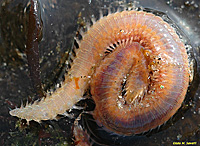
California Fireworm, Pareurythoe californica; La Jolla, CA
|
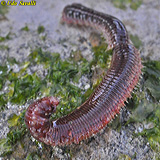
Blood Worm, Glycera sp., La Jolla, CA
|

Twelve-scale Worm, Lepidonotus squamatus, CT
|

Common Bristleworm, Linopherus sp.
|

Dried Bristle Worm specimen, Chloeia sp.
|

Dorvilleid Worm, possibly Dorvillea sp.
|

Lumbrinereid Worm, possibly Lumbrinereis sp.
|

Two models of likely polychaete annelids from the Cambrian Period: Canadia (left) & Burgessochaeta (right), roughly to scale with one another.
|

Leafy Paddleworm, Phyllodoce medipapillata; La Jolla, CA
|

Green Iridescent Worm, Arabella iricolor, La Jolla, CA
|

Sea Nymph (Nereis sp.?) epitoke (pelagic sexual) stage; La Jolla, CA
|
|
Class Polychaeta
Subclass Sedentaria — Tube and Fan-headed Worms
Characteristics
- Parapodia and chaetae often reduced or lost
- Most are sedentary, living in burrows or secreted tubes
- Many with feathery tentacles for feeding
- Mostly filter feeders or suspension feeders
- This subclass is probably paraphyletic
|
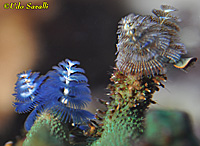
Christmas Tree Worms Spirobranchus giganteus; two color variations
|

Feather-duster Worm, Eudistyla sp.
|
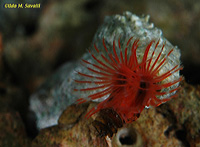
Red Tube Worm, Serpula sp.
|
|
|
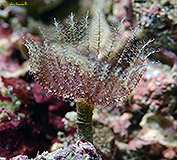
Brown Fanworm, Notaulax nudicollis (collected in Florida)
|
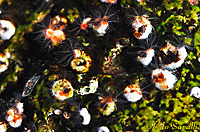
Spiral Tubeworms, Pileolaria sp. (note also acoel flatworm in lower left)
|
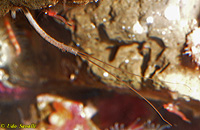
Spionid Tube Worm
|
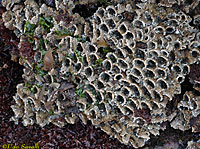
Sand-castle Worm tubes, Phragmatopoma californica; Calif.
|
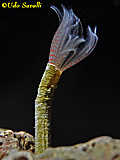
Fan Worm, Bispira sp.?
|
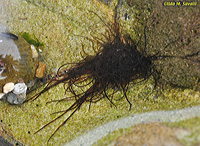
Spaghetti Worm, Terebella californica?, tentacles. The numerous fine tentacles are used to locate small food particles.
|
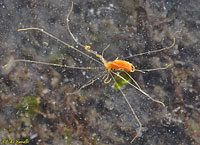
Small Unidentified Spaghetti Worm; Calif.
|

Giant Tube Worm, Riftia pachyptila, from deep-sea volcanic vents; preserved specimen
|
|
Polychaetes of Uncertain Relationships
Characteristics
- Polychaete worms that do not fit into the other groups
- Parchment worms (Family Chaetopteridae) are perhaps the most basal of the annelid worms
- Aelosomid worms were thought to be oligochaetes due to their fresh-water habits, but may be polychaetes instead
|
|
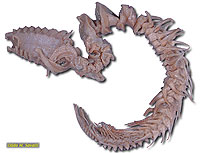
Parchment Worm, Chaetopterus sp., preserved specimen
|
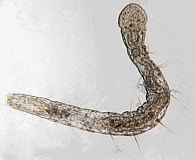
Freshwater worm Aeolosoma sp.
|
|
Class Clitellata
Subclass Oligochaeta — Earthworms
Characteristics
- Few chaetae; lack parapodia
- Little structural specialization of head
- Presence of clitellum (forms muscus and egg cocoon)
- Mostly in terrestrial or fresh water environments
|

Dissected Earthworm, Lumbricus sp.
See also labeled photo.
|

Earthworm, Lumbricus sp., CA
|

Fresh-water worm, Dero sp.
|
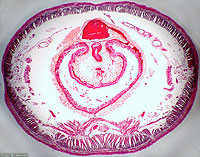
Earthworm, Lumbricus sp., stained cross-section slide, posterior to clitellum; 40x
See also labeled photo.
|
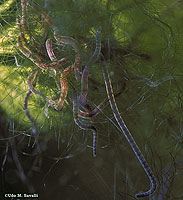
Tubifex sp. Worms, a fresh-water species
|
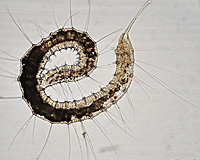
Fresh-water worm, Pristina (Stylaria) sp.
|
|
Class Clitellata
Subclass Hirudinea — Leeches
Characteristics
- Segmenting less defined; body not divided by septa
- Clitellum present
- Lack setae or parapodia
- Have a posterior sucker and usually also an anterior sucker
- Mostly in fresh water, a few are marine and semi-terrestrial
- May be scavengers, predators, or external parasites
|

Leech, wholemount slide
See also labeled photo.
|

Freshwater leech Helobdella sp.; Phoenix, AZ
|

Ribbon leech, Nephelopsis obscura, showing ventral surface and suckers
|

Scavenging leech, Erpobdella sp., KY
|
|
Class Echiura — Spoon Worms
Characteristics
- Unsegmented (most likely secondarily lost)
- Muscular, non-retractable proboscis with a groove (gutter)
- Many have chaetae or warty skin
- Long gut with with posterior anus
- Marine sediments: deposit or suspension feeders
- Formerly considered a separate phylum
|

Innkeeper Worm, Urechis caupo, preserved specimen
|
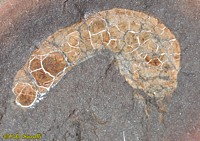
Fossil Spoon Worm, Coprinoscolex ellogimus; 300 Ma, IL
|
|
Class Sipuncula — Peanut Worms
Characteristics
- Unsegmented (secondarily lost?)
- Anterior introvert can be fully withdrawn
- Fluid-filled tentacles around mouth
- Gut U-shaped; anus near introvert
- Live in marine sediments
- Formerly considered a separate phylum
|

Dissected Peanut Worm, Sipuncula sp.
See also labeled photo.
|
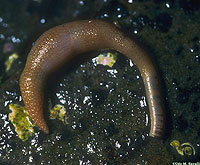
Peanut Worm, Phascolosoma agassizzii, CA
|

Peanut Worm, Phascolosoma sp.
|
|
|







































